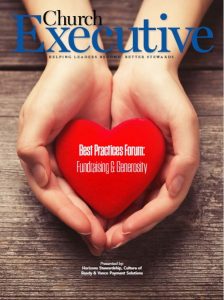
By Doug Turner
A major donor is an individual with high financial capacity. These donors are usually solicited 20 to 25 times a year with intentionality from other organizations.
Normally, they will support fewer than five.
Navigating generosity with major donors often seems perilous in the local church. Pastors are afraid of being misunderstood (i.e., showing favoritism to those with deep pockets, seeing dollar signs when they look at a church member, etc.) when engaging major donors. Leaders are hungry for a generosity approach consistent with their values, but they often struggle finding the right fit. As a result, many leaders stay on the sidelines, afraid to fully resource the church’s vision.
Complicating matters further, those with financial capacity often are reluctant to give at the highest level to the local church for fear it will disrupt the stewardship ecosystem. This is compounded when the potential donor doesn’t hear vision in terms to merit a significant investment, and other causes outside the local church often benefit as a result.
How do we engage major donors?
As pastor, the answer to that question will shape the ministry reach of your church. Engagement means focusing on the well-being of the giver, as well as the stewardship potential of the church.
1) Develop a discipleship approach to the major donor audience. The label itself (major donor) can create problems. It implies you commodify the person instead of pastor the person.
Paul challenged Timothy to focus on those “rich in this world” to discover “true life” (1 Timothy 6:18-19). More than most, people of affluence can live under the illusion that life is “my stuff.” By challenging them to give, you genuinely help them to discover life isn’t “my stuff,” but true life is one vested in the gospel of Jesus.
2) Engage relationally before you seek financial support. Building authentic relationships will be part of the discipleship model. Speak into their lives, and encourage them to speak into your ministry.
3) Treat each major donor as an investor in work of the church. When major donors consider giving, they often take the perspective of an investor. They will ask questions. They might push back on a project and suggest alterations.

As a leader, this isn’t to suggest you acquiesce to concerns. You might need to stand strong as a leader. The value is in the openness. You normally gain respect in the leadership moment.
Major donors want to understand the return on investment (ROI) for the ministry. Two axioms to consider:
If you want deep commitment to vision, you have to give someone permission to disagree with it first. With no ability to probe and question, you might receive a casual response but seldom a deep response.
They will respond to bold vision. Don’t be afraid to “go big or go home” in the discussion. Engaging major donors will help you match the scope of the initiative / project with your church’s potential.
4) Invite major donors into the mission of the church. Often, the major donor audience is sitting on the sidelines regarding time and talent. Hectic schedules contribute to the inactivity, but also underuse of individual gifts.
We ask someone to do a job at the church, but we don’t ask him / her to think or strategize on a critical ministry move. Frankly, high-capacity givers usually aren’t looking for a job; they are looking to exercise gifts.
5) Create conversational models instead of presentational models for generosity. Major donors process generosity out of a conversation more than a presentation.
Aristotle wrote that democracy is experienced in the “one, the few, and the many.” Stewardship development is processed in the one, the few, and the many in your church. The major donor will flourish in the “one” individual, conversational setting.
6) Demonstrate how major gifts catalyze generosity instead of restraining overall generosity. If you have a major initiative, gaining momentum is a challenge. High-capacity givers will create escape velocity to overcome inertia. They create the “big Mo.” Contrary to many donor assumptions, major gifts don’t discourage broader support; they actually catalyze wider generosity.
Engaging high-capacity givers will have major impact on the growth of the individual, the church, and the scope of ministry. You should strongly consider engaging this audience.
If you don’t, I promise somebody else will.
Doug Turner is founder and President of Culture of Ready, as well as lead pastor of Grove Chapel in Eatonton, Ga. Turner has helped churches raise more than $1.5 billion for capital and ministry needs.
Culture of Ready is a dedicated team committed to helping churches flourish through stewardship principles in a customized cultural experience and generosity campaigns. Working with some of the leading churches in America (including Willow Creek Community Church, Redeemer Presbyterian Church and Menlo Park Presbyterian Church, to name a few), Turner and his team view each church through a unique cultural context.



Great work.
How do I join the team you support.?
Am preparing to begin an upcountry church ministry with a community helping project but am seeking partners in this.
Thank you.